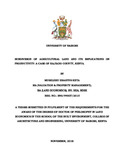| dc.description.abstract | Efficient, optimal and sustainable agricultural production, including extensive pastoralism systems, usually requires large contiguous land to enable economies of scale and synergy. These requirements may be absent when the private agricultural land is subdivided into small sizes and fragmented into idle lands or non-agricultural land uses. This claim is further confirmed by the law of diminishing marginal returns which shows that intensification of land use has a limit. Despite this knowledge, subdivision of private agricultural land into small parcels, even in drylands, is happening in Kenya. Therefore, subdivision and fragmentation of agricultural land may lead to increased agricultural production costs and negative change in agricultural productivity resulting to a tragedy of spatial anticommons.
According to Heller’s (1998) anticommons theory, when too many profit maximising individuals are endowed with exclusion rights in a scarce resource, they are likely to waste the resource by underutilizing it as they tend to block each other from access and use leading to a tragedy of spatial anticommons. Anticommons properties are, however, not necessarily tragic, thus there is need to understand the phenomenon of subdivision of private agricultural land into small units and their implications on productivity.
It is in this context that this study sought to create knowledge on the phenomenon of subdivisions of private agricultural land into small sizes by establishing the trends, drivers and implications of agricultural land subdivisions on agricultural productivity in the dry agricultural lands of Kajiado County. It is assumed that this knowledge will help land administrators and managers to put in place informed interventions to control untimely, unproductive and unsustainable agricultural land subdivisions.
The study focused on the issue of private agricultural land subdivision in the rural Kitengela Division, Kajiado County, Kenya. The methodology used involved a cross-sectional survey design whereby a total of 357 agricultural parcels and landowners were targeted. Self-administered questionnaires/schedules were thus administered to the target respondents. Other respondents in the study included land officials, real estate agents and
property developers in the study area. The overall survey response rate of the study was about 62%, which was adequate for analysis and generalization purposes. Statistical Package for Social Sciences (SPSS) was mainly used to perform data analysis which involved; cross tabulations, descriptive statistics, correlation and multiple regression analysis.
By use of mean scores and critical z-test, the study determined significant drivers influencing subdivision of agricultural land in the study area to be; agricultural land inheritance practices (
Xkg52.
= 3.8, z = 42.32), individualization of titles ( X k g 52 . = 3.7, z = 32.06), price/value of agricultural land ( X k g 52 . = 3.2, z = 30.89), demand for urban housing ( X 52 k g. = 3.2, z = 26.54) and future expectations on the value of agricultural land ( X k g 52 . = 3.2, z = 25.89), among others.
The results of correlation analysis of agricultural productivity of sheep/goats, cattle and maize against the agricultural land size using Pearson correlation (2-tailed) at 95% confidence level resulted to correlation coefficients of; r = - .216, p = 0.002; r = - .195, p = 0.005 and r = -.028, p = 0.002, respectively. The weak inverse association was further confirmed by the multiple regression coefficients whereby the relationship between sheep/goat and cattle productivity was determined to be B = - .003, p = 0.000 and B = - .001, p = .009, respectively. The B coefficients associated with maize productivity, and taking only crop land size (usually a portion of the total land size) into account, was found to be 1.247, p = .000. When the total agricultural land size was considered in the MRA model, however, the B coefficient was found to be - .001, p = .679, signifying an insignificant negative and weak correlation between the two variables.
This inverse weak relationship between agricultural land size and agricultural productivity confirms that anticommons properties are not necessarily tragic. The study, therefore, recommends that agricultural landowners be encouraged to practice modern and intensive agriculture such as zero grazing, use of more variable inputs, high value crops, mixed cropping and irrigation. Besides, the County governments should prescribe the allowable minimum agricultural land sizes in their areas of jurisdiction. | en_US |



